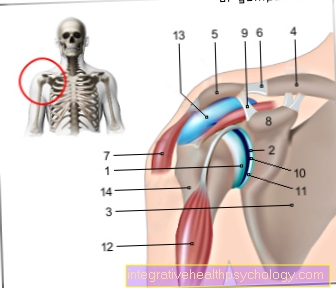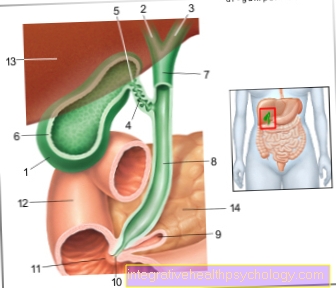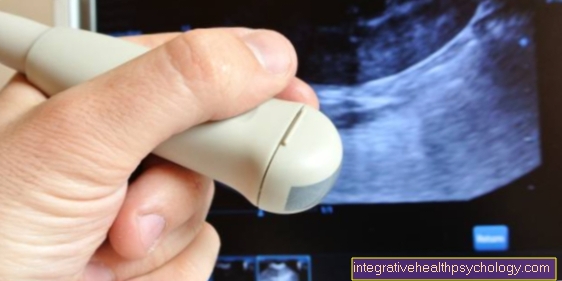Vitamin A deficiency
introduction
Vitamin A, along with vitamins D, E and K, is one of the fat-soluble vitamins in the body and comes in three different configurations: retinol, retinal and retinoic acid. These three substances are usually grouped together as “retinoids”, even if, strictly speaking, they act in different places in the body. What they have in common is the precursor beta-carotene, from which they can all be made. Beta-carotene is mainly found in carrots, but also in other yellow vegetables. Due to its solubility in fat, the vitamin can be difficult to excrete and can therefore accumulate in the body. Caution is therefore advised when taking appropriate vitamin preparations.

Symptoms of Vitamin A Deficiency
The symptoms of a vitamin A deficiency result from the effective areas of the various forms of vitamin A: Retinal plays a major role in the visual process. Because it is a basic building block for the production of molecules (so-called. Rhodopsin), which indicate the incidence or absence of light rays in the photoreceptor cells of the retina. Visual disturbances, especially in the dark, are therefore the most common symptom of vitamin A deficiency. The other forms of vitamin A, retinol and retinoic acid, play an important role in the regulation of genes and the maintenance of tissues, such as mucous membranes, nerve cells, bones and connective tissue. Accordingly, a vitamin A deficiency can also make itself felt through defects in these tissues. Children especially need vitamin A for their bone development. Vitamin A also plays an important role in embryonic development: Here it ensures that the nervous system is properly established.
Symptoms on the skin with vitamin A deficiency
Vitamin A, as retinol and retinoic acid, ensures the maintenance of almost all tissues. A deficiency can therefore also be identified in the skin and mucous membranes: dry, cracked or inflamed skin can be an indication of a chronic vitamin A deficiency. Torn corners of the mouth (rhagades) or acne (acne vulgaris) are also typical. Rosacea (copper lichen) can also be a consequence of a vitamin A deficiency. However, all of these phenomena are extremely unspecific and can also have many other causes. Should these problems arise, they should therefore always be viewed in a larger context. It must be clarified whether other symptoms of a vitamin A deficiency are recognizable and whether there could be a cause for a deficiency.
You may also be interested in the following article: Torn corners of the mouth - causes and tips for treatment
Symptoms on the hair with vitamin A deficiency
By maintaining the body tissue, vitamin A also ensures healthy skin, and thus also the so-called skin appendages. This includes hair and nails, for example. A vitamin A deficiency can also show up here: If the nails are thin and brittle, this can indicate a deficiency just as much as increased hair loss or thin and brittle hair. Vitamin deficiency syndromes are rare, especially in the first world countries, as there is always an adequate supply of food. In addition, the liver always has a certain amount of vitamins in store. A vitamin deficiency therefore develops very slowly and only in the case of chronic undersupply. Symptoms on hair, nails and skin should therefore be observed over a longer period of time and only arise over a longer period of the vitamin deficiency.
Symptoms of the eyes with vitamin A deficiency
Vitamin A and especially the retinal configuration are fundamentally involved in the visual process, as the so-called rhodopsin is produced from it. Typical early symptoms of vitamin A deficiency are visual disturbances and night blindness. On the retina there are the photoreceptor cells in which a chain reaction is triggered when light falls on them. This chain reaction involves several molecules that take on a different configuration during this process - something like knocking over the first stone in a row of dominoes: one after the other, the stones adopt the “overturned” configuration. In the case of a vitamin A deficiency, one stone in the row is missing in some cells, namely rhodopsin. Accordingly, the transmission of the light stimulus in these cells is hindered. So this does not lead directly to blindness, but with chronic deficiency more and more cells lack the necessary rhodopsin. Visual disturbances initially manifest themselves in night blindness, later blurred or blurred vision and light sensitivity are also possible.
How do I recognize a vitamin A deficiency myself?
The symptoms of a vitamin A deficiency are very unspecific. A vitamin A deficiency is therefore best recognized as such when the symptoms are alleviated after increased intake of vitamin A or when many of the associated symptoms are present. Symptoms that generally indicate a deficiency can be seen particularly in the skin and eyesight. If the skin is dry and is prone to cracks that do not heal well (for example at the corners of the mouth), this can be an indication of a deficiency. It is the same with often inflamed and poorly healing gums. Brittle nails or hair loss can also be noticed. A vitamin A deficiency also manifests itself in the eyes and eyesight, usually even earlier than on the skin. Anyone who notices that their eyesight deteriorates at night (night blindness) should therefore ask themselves whether there might be a vitamin A deficiency.
You may also be interested in the following article: Dry skin - causes and care tips
This is the cause of vitamin A deficiency
The cause of a vitamin A deficiency is usually a reduced intake combined with an increased consumption of this vitamin. The cause of a disturbance in absorption can be an impaired absorption of fat in the intestinal tract (since vitamin A is fat-soluble). This happens, for example, by taking so-called blood lipid lowering drugs (cholesterol lowering drugs) or because of existing problems with the liver, gall bladder or pancreas. The reduced intake can also result from an unbalanced diet, although vitamin A is found in a very wide range of foods. For example, children have increased consumption due to their growth, smokers, people who are very stressed, people who have just had an operation and people who are heavily exposed to the sun (this applies especially to fair-skinned people). In addition, certain sleeping pills increase consumption. Alcohol worsens both the absorption and storage of vitamin A, which takes place mainly in the liver. Men generally have a higher requirement than women and should therefore pay particular attention to the consumption of products containing vitamin A if they suspect a deficiency. It should also be borne in mind that up to a third of the vitamin A contained is lost through cooking.
What are the consequences of vitamin A deficiency?
Serious consequences of a vitamin deficiency occur extremely rarely in industrialized countries due to the good food supply and only with steadily increasing consumption of the respective vitamin or with chronically one-sided diet. Initially, there are lighter consequences and symptoms that indicate a corresponding undersupply. These typically include susceptibility to infection, night blindness, blurred vision, sensitivity to light, cracked and poorly healing skin and mucous membranes, and dry eyes. If the vitamin A deficiency is not remedied, possible long-term consequences are growth disorders (particularly affecting the bones) in children and adolescents as well as an increased risk of arteriosclerosis (vascular calcification), tumors and kidney stones.
This is how the diagnosis of vitamin A deficiency is made
It is practically impossible to diagnose a vitamin deficiency from the blood: Vitamin A is initially only bound to proteins in the blood, as it is fat-soluble and therefore water-repellent. However, the majority of all vitamins are stored in the liver cells and therefore cannot be detected in the blood at all. The exception to this is the oversupply of a vitamin (hypervitaminosis), in which the excess which the liver can no longer absorb circulates in the blood. In such cases, the vitamin A binding protein can then be detected in the blood serum. The best way to diagnose a vitamin A deficiency is through the presence of the various associated symptoms.
How can you fix a vitamin A deficiency?
Anyone who suspects themselves to be vitamin A deficient or has an increased need should pay attention to an increased intake of vitamin A. This is usually quite easy through diet, as vitamin A is contained in a very wide range of different foods. Foods that are high in vitamin A include sweet potatoes, carrots, pumpkin and apricots. Egg yolks, salmon, butter and milk are animal sources. As a rule of thumb, orange or yellow foods usually have a high content of vitamin A, as the precursor of vitamin A, beta-carotene, appears yellow to orange to humans. These foods should ideally be stored away from light, as otherwise the vitamin A can break down. You can also take vitamin A tablets. These are available in the drugstore or without a prescription in the pharmacy. In the event of an overdose, the skin turns yellow to brownish at first. This is a warning sign, but not dangerous. However, a longer overdose can lead to diarrhea, vomiting, headache, liver damage, hypothyroidism and bone breakdown (osteoporosis) as well as growths of the periosteum. It is therefore important to ensure that a dose of more than 15 mg (= 50,000 IU) per day is not taken for a long time.



.jpg)





.jpg)



















